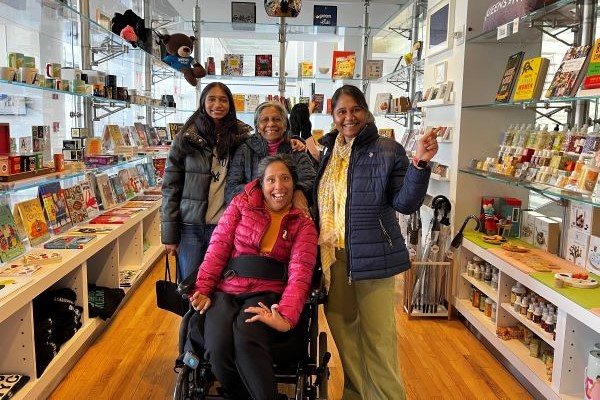
As July is Disability Pride Month, the obvious choice is Lakshmee Lachhman-Persad. The digital marketer has a wheelchair-using sister, Annie Lachhman, who was born with cerebral palsy. The Guyana-born siblings founded and run the Accessible Travel NYC website, a great source for planning, carrying out, and enjoying tourism in the Big Apple, thanks to their anecdotes, images, and tips.
Great Eats
Arepa Lady is a beloved Jackson Heights destination for authentic Colombian arepas, and it has quickly become one of our favorites. The arepas, with their crispy exterior and soft, cheesy interior, have a special place in our hearts. The arepa de choclo with chorizo, grilled chicken, and shrimp are all absolutely delicious. The menu also features tasty empanadas and other traditional Colombian snacks, along with delightful fruit drinks—our top picks are the mango and guanabana made with milk! The homey and welcoming setting adds to the charm. Originating as a popular street food cart by María Cano, Arepa Lady’s rich history shines through in every bite.
Accessibility: Arepa Lady is wheelchair accessible. Although the aisles are tight, staffers went out of their way to move chairs and ensure we could get to our seating comfortably. Their attentiveness and accommodation made for a pleasant dining experience. It’s a small space that can get quite crowded during peak dining hours, so planning a visit during quieter times might make it easier.

Unique Treats
Located in Flushing Meadows Corona Park, Queens Museum is a center for art and culture with diverse exhibitions. We visited to see Emilie L. Gossiaux’s Other Worlding exhibit to support disabled artists and their contributions to culture. While there, we were pleasantly surprised by the diverse products in the store. The shop features a range of items, including unique apparel, posters, prints, and books related to the exhibitions. Additionally, it features locally made products, such as honey, enamel pins, and vegan leather pouches. We were especially delighted by the wide selection of books that celebrate a variety of identities — disability included — and stories, possibly more than any other museum shop in New York City. We highly recommend a visit.
Accessibility: Queens Museum provides wheelchairs and offers resources like large-print labels, Braille transcriptions, and assistive-listening devices. The staff is attentive and accommodating, ensuring an inclusive and engaging experience for all visitors.

Wander Streets
Walking and wheeling through Jackson Heights offers a unique glimpse into the vibrant neighborhood’s blend of cultures with a variety of shops, restaurants, and markets to explore. Given our Indo-Caribbean heritage, we’re drawn to the Southeast Asian shopping for Indian clothing (i.e. shalwars, 22-karat gold jewelry) and traditional sweet treats such as barfi and jalebi. It’s also a grocery lover’s paradise where we find cooking spices and Caribbean vegetables that we’re familiar with.
Accessibility: The sidewalks and curb cuts in Jackson Heights are generally wide and well-maintained, suitable for wheelchairs. While some shops and restaurants are on the street level, it’s always good to check ahead for specific accessibility features at smaller establishments.

Historic Feats
The Louis Armstrong House Museum offers an intimate look into a Jazz legend’s life. We thoroughly enjoyed exploring the preserved Corona home, filled with personal artifacts, recordings, and memorabilia. The museum also hosts events, workshops, and concerts celebrating the trumpeter-bandleader’s legacy. The guided tour provided us with fascinating insights into Armstrong’s life, career, and the significant impact he had on Jazz music. The house is a beautifully maintained historic site, reflecting the personality and lifestyle of Armstrong and his wife, Lucille. Beyond the musical genius, we learned so much about Louis and Lucille as humanitarians, social justice advocates, and community activists. Lucille’s strong will and determination, exemplified by her purchasing the home and managing Armstrong’s career and finances, were particularly inspiring. We also loved discovering Satchmo’s special recipe for red beans and rice, adding a personal touch to our visit.
Accessibility: The House Garden is wheelchair-accessible. So is The Louis Armstrong Center, which is across the street from the house and features a welcome desk, museum store, exhibition area, restroom, and performance space. The house tour requires the ability to climb two sets of steep stairs and stand for 45 minutes. Visitors unable to take the tour receive a virtual tour instead. The staffers were all very welcoming and friendly, making our visit memorable.

Disability Pride Month
True to its name, Disability Pride Month celebrates people who live with disabilities, promotes their contributions to society, and tries to erase prejudice against them. It stems from the Americans with Disability Act, which became United States law on July 26, 1990.
